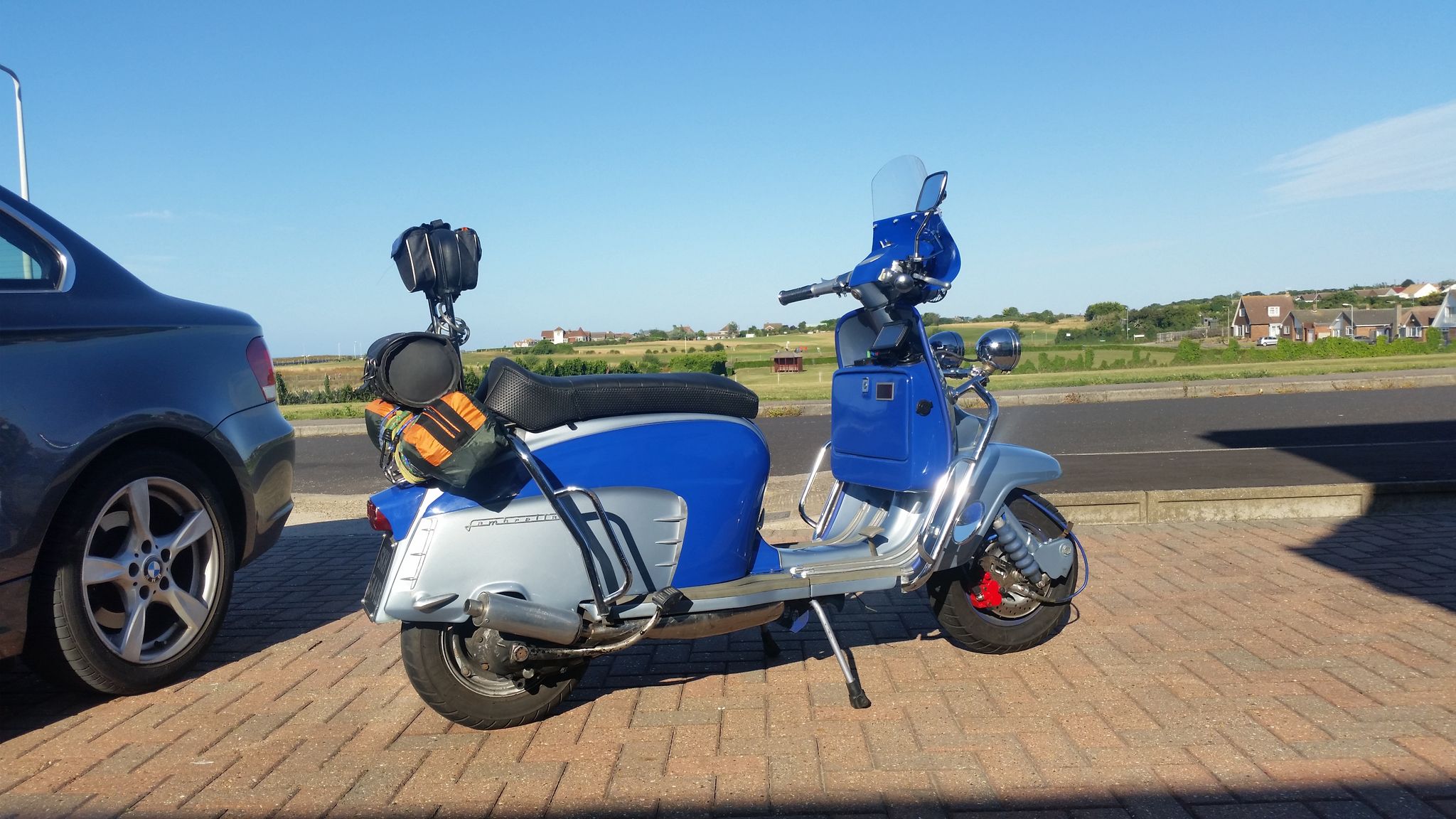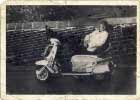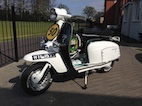LCGB Forums
The ability to post messages is restricted to LCGB members. Any questions contact us at lcgbadmin@googlemail.com
Tubeless rims
25 posts
• Page 1 of 2 • 1, 2
Tubeless rims
Hi, I'm thinking of getting some tubeless rims for my scoot. Are there still issues with the AF ones or has that been sorted now ?
Cheers.
Cheers.
-

SILGP - Posts: 52
- Joined: Tue Jan 19, 2016 12:57 pm
- Location: Leeds
Re: Tubeless rims
I have only just entered the world of of tubeless. I have, by hand, fitted tyres onto 5 AF rims. All have been good.
"Soft" walled tyres are fine. Reinforced walls are a real issue like Heidenaus.
The rims are cool. No experience if SIP rims though
"Soft" walled tyres are fine. Reinforced walls are a real issue like Heidenaus.
The rims are cool. No experience if SIP rims though
-

Storkfoot - Posts: 2443
- Joined: Fri May 30, 2014 8:59 pm
- Location: Merseyside
Re: Tubeless rims
Thanks for your reply. Did you have any problems with accessibility to the valve on the rear wheel when it was fitted on the scooter ?
-

SILGP - Posts: 52
- Joined: Tue Jan 19, 2016 12:57 pm
- Location: Leeds
Re: Tubeless rims
Hmm. We selected SIP rims in 2012 due to the preference for them as they ‘fit’ the hub as OEM rims do, which we believed to be very important.
The issue was debated extensively within the BSSO & on Forums.
I have no idea if the AF rims have since been redesigned to also ‘fit’ the hub.
The issue was debated extensively within the BSSO & on Forums.
I have no idea if the AF rims have since been redesigned to also ‘fit’ the hub.
- Warkton Tornado No.1
- Posts: 2257
- Joined: Sun Jan 11, 2015 1:27 pm
Re: Tubeless rims
Yes, true. I just filed a bit off the hub and I also have a 90 degree adaptor too.
On the plus side, I believe that is reasonable as opposed to having to change hub studs.
On the plus side, I believe that is reasonable as opposed to having to change hub studs.
-

Storkfoot - Posts: 2443
- Joined: Fri May 30, 2014 8:59 pm
- Location: Merseyside
Re: Tubeless rims
Do they now sit on the hub as they should do?
Did you file the hub and the rim ?
Looking to change up from my ScootRS rims. AF's a lot cheaper than SIP but I would have concerns about how they sit.
Cheers
Did you file the hub and the rim ?
Looking to change up from my ScootRS rims. AF's a lot cheaper than SIP but I would have concerns about how they sit.
Cheers
-

CHRIS in MARGATE - Posts: 4080
- Joined: Fri May 30, 2014 5:49 pm
Re: Tubeless rims
I have done thousands of miles on AF rims on my GP, including Euros without any issues with them. Only thing I would say is use the wider one on the rear for better valve clearance as I had to grind some fin off on one of mine.
Rich'
Rich'
-

Rich Oswald - Posts: 9811
- Joined: Fri May 30, 2014 3:30 pm
- Location: Wiseman From The East (East Of The Pennines That Is)
Re: Tubeless rims
As you can see from these pictures, they do not rest on the hub. They are further away than originals.
But, my own view is that even original rims don't actually rest on the hub (they are very close) and I have only had the issue of the rim cutting into the hub studs when the nuts have worked loose, not at any other time. Actually, the only time I have had this is when I forgot to tighten up the wheel nuts


I have had no need to file the rims themselves.
But, my own view is that even original rims don't actually rest on the hub (they are very close) and I have only had the issue of the rim cutting into the hub studs when the nuts have worked loose, not at any other time. Actually, the only time I have had this is when I forgot to tighten up the wheel nuts


I have had no need to file the rims themselves.
-

Storkfoot - Posts: 2443
- Joined: Fri May 30, 2014 8:59 pm
- Location: Merseyside
Re: Tubeless rims
[quote="Storkfoot"]As you can see from these pictures, they do not rest on the hub. They are further away than originals.
But, my own view is that even original rims don't actually rest on the hub (they are very close) and I have only had the issue of the rim cutting into the hub studs when the nuts have worked loose, not at any other time. Actually, the only time I have had this is when I forgot to tighten up the wheel
and that is why we all should check all wheel nuts for tightness before every ride.
But, my own view is that even original rims don't actually rest on the hub (they are very close) and I have only had the issue of the rim cutting into the hub studs when the nuts have worked loose, not at any other time. Actually, the only time I have had this is when I forgot to tighten up the wheel
and that is why we all should check all wheel nuts for tightness before every ride.
- roli150lam
- Posts: 1792
- Joined: Fri May 30, 2014 8:16 pm
- Location: Lincoln
Re: Tubeless rims
On the second photo,the AF rims look quite a long way from the hub meaning the whole weight of the scooter is on four hub studs.
-

HxPaul - Posts: 1583
- Joined: Fri May 30, 2014 9:18 am
- Location: Halifax
Re: Tubeless rims
As previously stated, the topic of the AF tubeless rims & the ‘design change’ from the OEM type (where the hub supports the rims, to the extent that paint may be scuffed) has been debated extensively.
My belief is that they are not as good as other rims that fit the hubs.
Anybody with the scantest knowledge of risk assessment should realise that they are riskier than rims designed to fit the hub.
The only reason that they can have been released for sale like that is due to a cock up.
I’d rather hoped that somebody else would avoid me having to say this as I’m consciously trying to avoid Forum members spitting their dummies out, but, when it comes to a safety issue, I feel compelled to try & give an honest opinion.
So, no offence to anybody, but it can only come down to money for them to be recommended over rims that fit! Either by those selling them or by those advocating the ‘bargain’ that they may be.....
My belief is that they are not as good as other rims that fit the hubs.
Anybody with the scantest knowledge of risk assessment should realise that they are riskier than rims designed to fit the hub.
The only reason that they can have been released for sale like that is due to a cock up.
I’d rather hoped that somebody else would avoid me having to say this as I’m consciously trying to avoid Forum members spitting their dummies out, but, when it comes to a safety issue, I feel compelled to try & give an honest opinion.
So, no offence to anybody, but it can only come down to money for them to be recommended over rims that fit! Either by those selling them or by those advocating the ‘bargain’ that they may be.....
- Warkton Tornado No.1
- Posts: 2257
- Joined: Sun Jan 11, 2015 1:27 pm
Re: Tubeless rims
You won't get any disagreement from me on this Warkton. I'd much prefer the wheel to be centralised and locate on the hub than just to be held by the four studs.
- Sticky
- Posts: 274
- Joined: Wed Jul 02, 2014 12:28 am
Re: Tubeless rims
Thanks for all your replies - I think I'll go for the SIP rims after reading that.
Cheers.
Tony.
Cheers.
Tony.
-

SILGP - Posts: 52
- Joined: Tue Jan 19, 2016 12:57 pm
- Location: Leeds
Re: Tubeless rims
My opinion on this subject is that the wheel rim was never designed to bear the load on the flimsy edge to begin with. Back in the 50's, when these were designed, it would have been quite acceptable to carry 5 hp and two lightweight skinny Italians on 4 x M8 studs with spring washers and nuts. Try sticking a hub in a lathe and check it for 'out of round'. It's scary sometimes.
Move on to 2017 and we have 30HP, Two fat old pensioners, Enough luggage to sink the Titanic, Pothole ridden roads and performance capable tyres. (would you trust a Moggy minor with 300Hp through the drive train on the original wheels?)
As Storkfoot pointed out, It's only really a problem if the nuts come loose and elongate the holes and start shearing through the studs.
Re-engineer this fixing to modern standards and tolerances, and the problem miraculously goes away and its easier to do with ally rims than steel ones.
Move on to 2017 and we have 30HP, Two fat old pensioners, Enough luggage to sink the Titanic, Pothole ridden roads and performance capable tyres. (would you trust a Moggy minor with 300Hp through the drive train on the original wheels?)
As Storkfoot pointed out, It's only really a problem if the nuts come loose and elongate the holes and start shearing through the studs.
Re-engineer this fixing to modern standards and tolerances, and the problem miraculously goes away and its easier to do with ally rims than steel ones.
-

Fast n Furious - Posts: 1716
- Joined: Sat Nov 19, 2016 3:56 am
- Location: York
Re: Tubeless rims
Fast n Furious wrote:My opinion on this subject is that the wheel rim was never designed to bear the load on the flimsy edge to begin with. Back in the 50's, when these were designed, it would have been quite acceptable to carry 5 hp and two lightweight skinny Italians on 4 x M8 studs with spring washers and nuts. Try sticking a hub in a lathe and check it for 'out of round'. It's scary sometimes.
Move on to 2017 and we have 30HP, Two fat old pensioners, Enough luggage to sink the Titanic, Pothole ridden roads and performance capable tyres. (would you trust a Moggy minor with 300Hp through the drive train on the original wheels?)
As Storkfoot pointed out, It's only really a problem if the nuts come loose and elongate the holes and start shearing through the studs.
Re-engineer this fixing to modern standards and tolerances, and the problem miraculously goes away and its easier to do with ally rims than steel ones.
Perhaps I’m just too dumb to understand the justification for rims that don’t fit the hub.
However, what I do know is that the ‘science’ of removable wheels that fit a hub is not unique to Lambretta or even V*spa. I can’t think of a car that doesn’t centre its wheels on the hub to take the load because those automotive engineers are well aware of the loads, particularly shock loads that can cause ‘slippage’ (as they say @ Land Rover) That’s why even ‘amateur’ car owners that adapt wheels of one marque to another use special centering rings to take the load through to the hub in the case of oversize wheel bores
.
So why would there be any possible benefit to rely entirely on four fasteners that are only Ø6.8 mm @ their core being completely shear loaded when that can be augmented by the larger diameter of the hub?
Why would a hub designed in the 50’s fitted with modern alloy rims run any truer utilising just the studs rather than the spigot diameter designed to centralise the rims? Having said that, I’d sooner have the rims fit the hub & have it running out of true than opt for rims that don’t fit.
Perhaps the fact that SIP rims are now TuV approved might add some weight to this debate...
- Warkton Tornado No.1
- Posts: 2257
- Joined: Sun Jan 11, 2015 1:27 pm
Re: Tubeless rims
I suspect that SIP would need to have TUV approval to legally sell them for use in Germany.
-

Fast n Furious - Posts: 1716
- Joined: Sat Nov 19, 2016 3:56 am
- Location: York
Re: Tubeless rims
Fast n Furious wrote:I suspect that SIP would need to have TUV approval to legally sell them for use in Germany.
Precisely.
“TÜV is a leading international expert in providing testing, product certification, qualification, training and knowledge services”
- Warkton Tornado No.1
- Posts: 2257
- Joined: Sun Jan 11, 2015 1:27 pm
Re: Tubeless rims
I decided to enquire about the problems with the tubeless rims with AF and received an email reply. I'd like to post it up on here as I think they deserve their say but am not sure how to do it - Is anyone happy for me to send them the email for them to then publish on here for me ?
-

SILGP - Posts: 52
- Joined: Tue Jan 19, 2016 12:57 pm
- Location: Leeds
Re: Tubeless rims
Can't you just copy the text and paste it into here?
-

burnside - Posts: 988
- Joined: Mon Jun 09, 2014 10:39 pm
- Location: Flying 8 Balls - Norwich
Re: Tubeless rims
Looks like I can Burnside 
Anyway , here is my reply from AF Rayspeed :
10. There is a gap between my hub and my new rim on the locating tabs of the hub will this cause a problem?
No. I have been asked this question many times so I will answer it a little more thoroughly. Many people believe the locating tabs on the hub are a load bearing structure and should be an interference (tight) fit, this has made them very concerned by the gap.
The Lambretta hub locating lugs were never intended to provide structural support to the rim. The structural support comes from the hub studs. As such to try to use these locating lugs to provide structural support would not only be a departure from their design intent but would also require a comprehensive redesign. First the numbers, then the explanation.
The new design of rim is based upon existing SIL pressed steel split rims. They share the same internal diameter as the rims we have been getting from India for the last 10 – 15 years. The vast majority of Lambretta scooters we have supplied in that time including our current stock have the same large internal diameter. We were the official Lambretta importer, we are not talking about a small number of bikes. All the split rims I currently stock have this same internal diameter. In all that time, and in all those rims I am not aware of a single failure that could be attributed to this design feature. To reiterate, this is not a design change, and it has not caused a problem over many thousands of rims.
Take a look at a standard Lambretta front hub. Look at how thick the rib of aluminium that is the locating lug actually is. It is not as thick as one of the 8.8 grade steel M8 studs that hold the wheel on. Cast aluminium has less than a third the tensile strength of steel. If this was meant to be the main support of the wheel surely it should be stronger than the stud. The locating lugs do not have close to enough strength to support the Lambretta wheel rim, because that was never their purpose.
The hubs and rims were painted from the factory. This means that even a tight fit between rim and hub was supposed to have two layers of paint between them. Paint is not that strong. If this area were load bearing, the paint would compress under load and move when force was applied. This does not happen because the hub studs take the load and never let the rim touch the locating lugs once they are correctly fitted.
Even very close fitting rims are not an interference fit. If the gap between the rim and the locating lug is half a thou or half a mile, it is still a gap and provides no structural support. Where the factory wanted an interference fit to provide structural support they could do it. Look at a rear hub cone. They were never supplied painted, the centre of the hub where the cone locates was never painted and neither was the layshaft. This is because they wanted an interference fit and that required a metal to metal contact.
I hope that goes some way to relieving people’s fears. But please do not take my word for it. Too many people believe what they are told without ever looking further than a web forum. Go check for yourself that what I say is true and backed up by the evidence. If you find I am mistaken or that there are other factors involved please let me know. If you would like a more detailed answer to this question please email us and I can send an unabridged copy.
Anyway , here is my reply from AF Rayspeed :
10. There is a gap between my hub and my new rim on the locating tabs of the hub will this cause a problem?
No. I have been asked this question many times so I will answer it a little more thoroughly. Many people believe the locating tabs on the hub are a load bearing structure and should be an interference (tight) fit, this has made them very concerned by the gap.
The Lambretta hub locating lugs were never intended to provide structural support to the rim. The structural support comes from the hub studs. As such to try to use these locating lugs to provide structural support would not only be a departure from their design intent but would also require a comprehensive redesign. First the numbers, then the explanation.
The new design of rim is based upon existing SIL pressed steel split rims. They share the same internal diameter as the rims we have been getting from India for the last 10 – 15 years. The vast majority of Lambretta scooters we have supplied in that time including our current stock have the same large internal diameter. We were the official Lambretta importer, we are not talking about a small number of bikes. All the split rims I currently stock have this same internal diameter. In all that time, and in all those rims I am not aware of a single failure that could be attributed to this design feature. To reiterate, this is not a design change, and it has not caused a problem over many thousands of rims.
Take a look at a standard Lambretta front hub. Look at how thick the rib of aluminium that is the locating lug actually is. It is not as thick as one of the 8.8 grade steel M8 studs that hold the wheel on. Cast aluminium has less than a third the tensile strength of steel. If this was meant to be the main support of the wheel surely it should be stronger than the stud. The locating lugs do not have close to enough strength to support the Lambretta wheel rim, because that was never their purpose.
The hubs and rims were painted from the factory. This means that even a tight fit between rim and hub was supposed to have two layers of paint between them. Paint is not that strong. If this area were load bearing, the paint would compress under load and move when force was applied. This does not happen because the hub studs take the load and never let the rim touch the locating lugs once they are correctly fitted.
Even very close fitting rims are not an interference fit. If the gap between the rim and the locating lug is half a thou or half a mile, it is still a gap and provides no structural support. Where the factory wanted an interference fit to provide structural support they could do it. Look at a rear hub cone. They were never supplied painted, the centre of the hub where the cone locates was never painted and neither was the layshaft. This is because they wanted an interference fit and that required a metal to metal contact.
I hope that goes some way to relieving people’s fears. But please do not take my word for it. Too many people believe what they are told without ever looking further than a web forum. Go check for yourself that what I say is true and backed up by the evidence. If you find I am mistaken or that there are other factors involved please let me know. If you would like a more detailed answer to this question please email us and I can send an unabridged copy.
-

SILGP - Posts: 52
- Joined: Tue Jan 19, 2016 12:57 pm
- Location: Leeds
25 posts
• Page 1 of 2 • 1, 2
Who is online
Users browsing this forum: No registered users and 13 guests